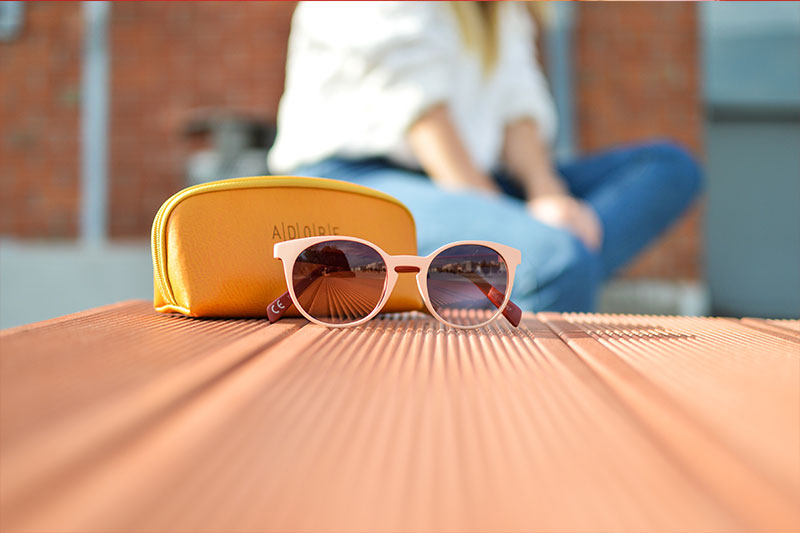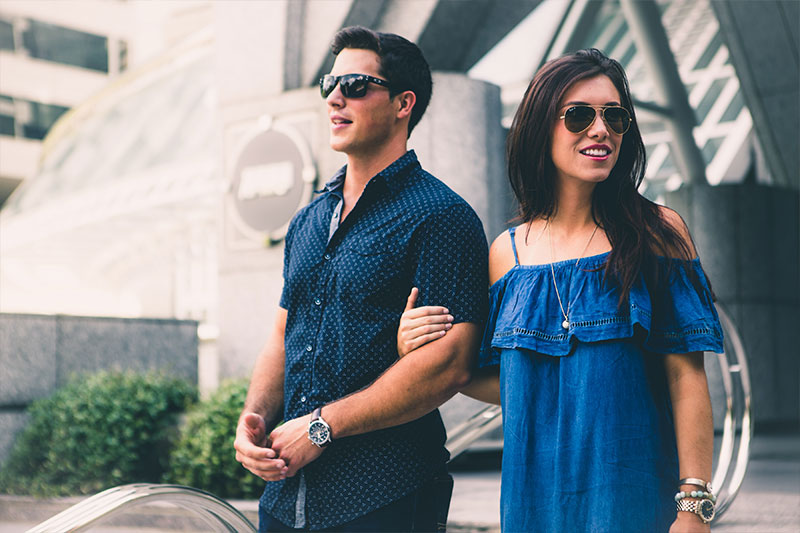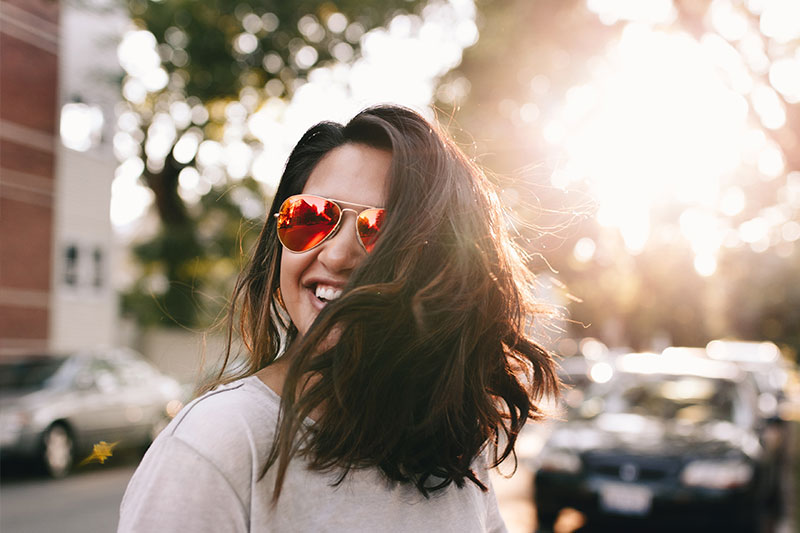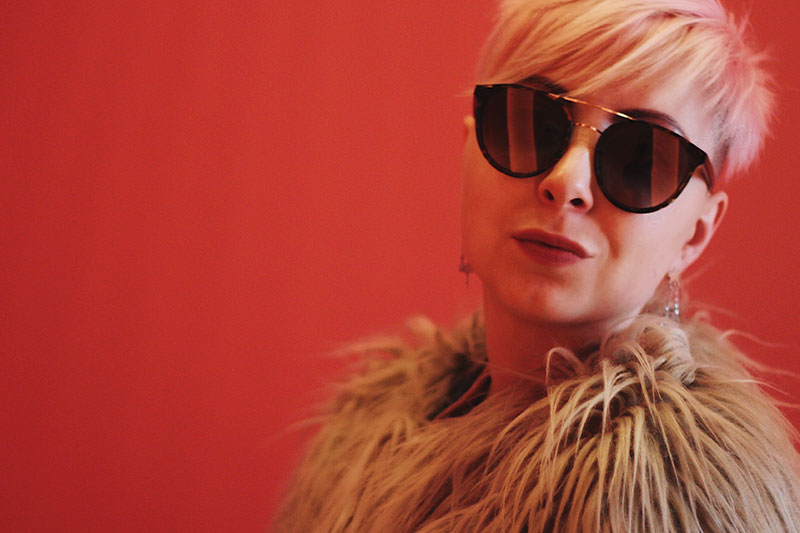Whether you’re in the car, at the beach or at the game, chances are you’re probably wearing sunglasses to keep the rays from overpowering your eyes.
And sure, we spend a lot of time picking out the perfect pair at the store so we can look good. Fashion matters. But the real reason sunglasses exist is so we can see well.
- The Inuit made sunglasses out of ivory, wood or bone to protect their eyes from the sun’s reflection off snow and ice. They carved out narrow eye slits to block out much of the ultraviolet radiation that could potentially cause sunburn of the eyes.
- Over 9 centuries ago in China, people used quartz lenses to reduce glare from sunlight.
- Nero, the notorious Roman emperor, supposedly cheered on the gladiator games peering through polished gems.
So here’s your chance to learn about the strange origins of sunglasses, the real reasons why they exist and what wearing them can do for your eye health.
Where did sunglasses come from?
All across the globe since the dawn of human history, people have found ways to adjust how light affects the eyes.
For some, like the Inuit, the walrus ivory coverings over their eyes prevented snow blindness. For the Chinese, the quartz lenses had an anti-glare function. And for scientists and lens grinders in the 1700s, tinted glass helped with sight correction, and then with light sensitivity for those with syphilis in the 1800s — until they realized it also helped with sun protection.
But it wasn’t until the mid 20th century that the various developments of sunglasses came together into what we know today.
We’ve got Sam Foster to thank for that. As founder of Foster Grant, he was selling cheap, mass-produced frames for sun protection to beachgoers and boardwalkers in Atlantic City back in 1929.
And we can thank Hollywood, too. Celebrity culture was rapidly growing, so actresses used sunglasses to evade the paparazzi and conceal their red eyes due to intense film lighting on set.
The aviation industry was also booming. Military pilots had been wearing the aviator style of sunglasses for a breadth of ray-blocking coverage necessary in the sun-soaked skies. The creators of the aviators, Ray-Ban, released them publically in 1937, and they quickly took off with Hollywood’s leading men and women.

Fashionable frames throughout the decades
As sunglasses got even more popular across the nation, certain frames became synonymous with the celebrities who wore them — and each decade brought a different look.
- The cat-eye style was popularized by the likes of Audrey Hepburn and Marilyn Monroe in the ‘50s.
- In the ‘60s, Jackie O’s large round frames hit it big.
- The round style continued into the 1970s, only in smaller, chicer designs. Dark lenses were swapped for colored lenses, and making a statement with your eyewear was as important as ever. (John Lennon and Yoko Ono, anyone?)
- The 1980s took color to the max with plastic frames in every color to perfectly match eye-catching outfits. Princess Diana’s white frames, refined yet cool, were an international hit.
- The wire frame came back in the ‘90s, though smaller and sleeker. Wraparounds and sporty looks blew up, too. Think the Olsen twins, MC Hammer or The Matrix.
And in the last 20 years, we’ve seen even more resurgences of styles with imaginative twists from on the runway to on the town. Check out the Optical Shop here at Perrysburg Eye Center. We love finding just the right style, classic or modern, that gets you the look you’re going for.

The science behind sunglasses
And we’ve barely scratched the surface of how science has shaped the development of sunglasses. Throughout the past century and into this one, we’ve seen so many scientific developments that have revolutionized protective eyewear.
And we’re totally here for it.
We’re pretty darn lucky to live when we do with all the eyewear options that don’t sacrifice fashion for function.
Most everyone knows nowadays that falling asleep on the beach without slathering on sunscreen is a bad idea. Scientific studies have shown time and again that it’s the healthy thing to do any and every time we are exposed to sunlight.
Prolonged exposure to ultraviolet sun rays without protection is harmful — never go out without sunglasses!
It’s just as true to say, according to the latest scientific research, that eyes are just as — if not more — susceptible to UV damage. At best, you might experience headaches and migraines or temporarily lose normal vision. At worst, you might experience significant, long-lasting pain or even suffer from serious eye conditions.
That’s why it’s the responsible thing to do to wear sunglasses. Prolonged exposure to ultraviolet sun rays without protection has absolutely zero benefits, so you should never go out without a good pair of sunglasses!
Luckily, it’s super simple to protect your eyes. Our biology has blessed us with eyes that are set back in the skull with lids, brows and lashes to keep them relatively safe. All we have to do extra is find a good pair or 2 (or 3) of sunglasses that have lenses made to block UV rays — and not all sunglasses are created equal.
When you get your next eye checkup or comprehensive eye exam, make sure to ask your ophthalmologist about any concerns you have, including changes in vision or sun protection advice.
You can also ask the opticians at the Optical Shop to point you in the right direction when it comes to finding the right pair(s) of sunglasses.
Not all sunglasses are created equal
“Sunglasses are sunglasses. As long as I’m wearing a pair, I’m good, right?”
We hear this all the time from people in Northwest Ohio, but it’s a misunderstanding across the nation. The world, even.
Because of that, we want to make it clear: Not all sunglasses are good sunglasses.
“What do you mean!?” you might ask.
Just wearing frames and lenses over your eyes doesn’t mean your eyes are protected.
In practical terms, we recommend that you don’t buy sunglasses just for the look or just for the price. You should purchase sunglasses that actually safeguard your eyes. And like we said, in the 21st century, you’ve got plenty of options of sunglasses that look good and keep your eyes safe. (Need help finding that pair? We’ve got your back.)

Wear ‘em whenever and wherever
According to the American Optometric Association, the right thing to do is wear sunglasses anytime you get any sunlight exposure to:
- Protect your eyes from UV rays (neglecting to do so might lead to cataracts).
- Block blue light, which has been linked to macular degeneration.
- Make vision more comfortable and accurate by not having to squint.
- Adapt when transitioning to darker environments, like indoors or while driving.
The AOA also suggests getting sunglasses that block at least 99% of both UV-A and UV-B radiation.
That includes the backs of your lenses, too. Even if you’re not looking in the direction of the sun, sneaky rays can reflect off the inside of the lenses and do just as much damage.
Polarization, scratch resistance plus anti-particulate and anti-static technology keep your sunglasses and your eyes in tiptop shape. Make sure to ask your eye care and eyewear professional about the health and safety features before you make a purchase.
Other features you might consider:
- Smudge resistance
- Water and oil repellence
- Easy cleaning solutions
You’ve only got one set of eyeballs, so investing in them — and a cool pair of powerful sunglasses — is the best thing you can do for them.
Why do I need to wear sunglasses?
Your eyes are powerful machines, but delicate ones.According to ophthalmologist Lisa Park, MD at Columbia University Medical Center, there are 3 eye health considerations that make eye protection essential:
1. “The first is the retina inside the eye. With age people can develop macular degeneration (which is the light-sensitive nerve tissue in the eye), and using sunglasses may protect these photoreceptors from UV damage.”
2. “The second is the lens of the eye; everyone eventually will develop clouding of the lens which is what you know as a cataract. Protecting the eye from sunlight may slow the progression of cataracts.”
3. “Lastly, skin cancer on the eyelids is a concern. Protection from sun exposure is recommended to prevent this condition, particularly in patients with a history of skin cancers.”
Protection from UV-A and UV-B rays is just a single reason why you need to keep the shades on outside, summer and winter alike.
To get a full picture of the importance of frames and lenses that actually help you, we’ve pulled together 7 more reasons why sunglasses shouldn’t be optional.
Enjoying this article?
Get more like this sent to your inbox!
Reduce your chances of skin cancer
The skin surrounding your eyes is extremely sensitive sunlight — and to UV damage. So much so that nearly 10% of all skin cancers start on the eyelids.
Thankfully not all of those are necessarily deadly, but tissue damage often takes place. Or even blindness.
The Skin Cancer Foundation suggests full-coverage sunglasses anytime you’re soaking up the rays (and comfort is important since you’ll need to wear them a lot!).
You don’t have to sacrifice fashion for function, either. Square frames look good on rounder faces, and round frames go over well with squarer faces.
Start at our Optical Shop to keep your eyes and the nearby skin protected.
Avoid UV damage to your eyes
UV rays can do irreparable damage to your retinas and lenses. Cataracts and macular degeneration are just a few of the problems that can develop if your eyes are exposed to the harmful light.
This is why sunglasses that block 99% to 100% of UVA and UVB radiation are so important.

Protect your eyes from the elements
It’s easy to forget that sunglasses aren’t just for sunny days. Or even just for summery days.
Even in the dead of winter, snow can reflect UV rays and cause snow blindness (something the Inuits figured out long ago). So instead of risking sunburn of your eyes — which can include vision loss and significant pain — it’s smart to wear sunglasses all year round to keep your eyes protected.
And sunglasses will also block wind and debris from irritating your eyes as well as protect you from dry eye.
Stay safe on the road while driving
You ever get in the car to go somewhere — and the next thing you know, you’re already there?
Driving is one of those things we do daily, so we really don’t give it a lot of thought. But every time you’re navigating down the highway, through the neighborhood or across the city, your eyes have lots of challenges to overcome:
- Blinding sunlight
- Bright lights from other vehicles
- Wet roads reflecting sunlight or streetlights
Play it safe — for you and your family’s sake — and use polarized sunglasses. You’ll significantly reduce your chances of an accident and keep your eyes protected in the process.
Steer clear of crow’s feet
Remember how delicate your skin is around your eyes? When you skip putting on sunglasses, not only are the sun rays slowing aging that skin, but you’re also squinting for long periods of time.
Wrinkles are a part of the natural aging process. But if you can skip unnecessary wrinkling due to negligence, why wouldn’t you?
Combat jet lag
Do you travel often? Then you’ll find this interesting: Researchers have found that wearing sunglasses before, during and after your flight helps you recover from jet lag more quickly.
The reason? You block out much of the light patterns you’re normally exposed to, making the transition to another time zone much easier.
And of course, the bonus is that you’ll look super cool to the other passengers.
Teach your children about eye safety
Only about half of kids have or wear a pair of sunglasses. It should be all.
Children’s eyes are much more transparent than adults’, so UV exposure can be significantly more harmful. Most UV exposure occurs before you’re 18, so parents: Make sure you’re setting an example for your kids.
Luckily there are lots of fun, funky frames that range from sparkly to sporty, depending on what your kids like. So do the right thing and take them to pick up some protective eyewear!
Sunglasses are your eyes’ best friend
You can look good and treat your eyes right. Just get yourself (and each person in your family, too) a great pair that blocks at least 99% UVA and UVB light and don them whenever you’re stepping out. Your eyes will thank you.
Need to get an eye exam to make sure your eyes are in great shape? Or want to check out our Optical Shop? Go ahead and reach out today!
